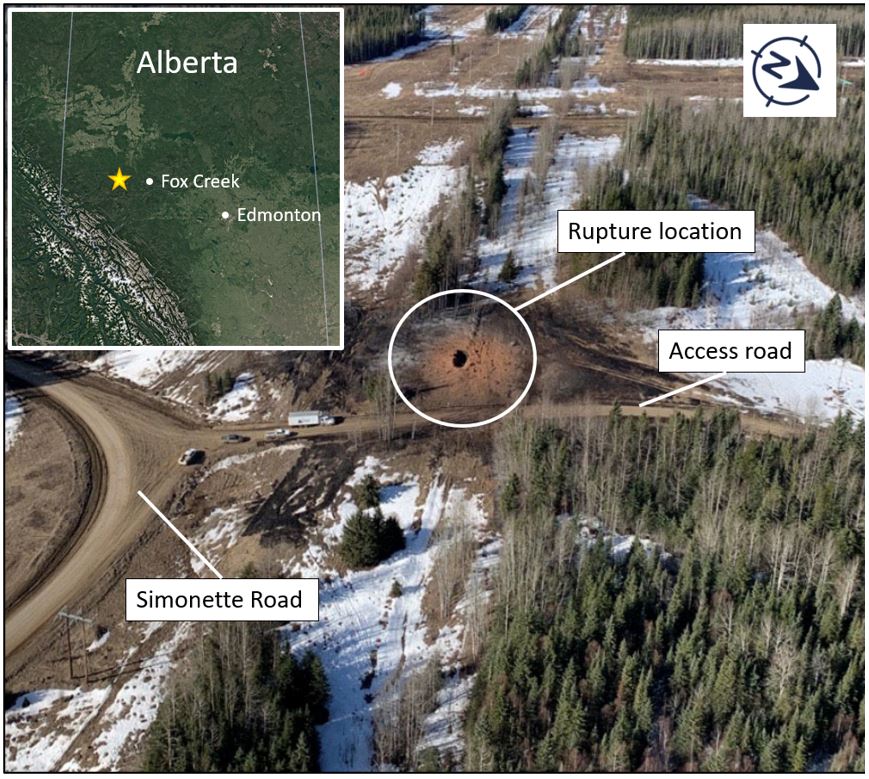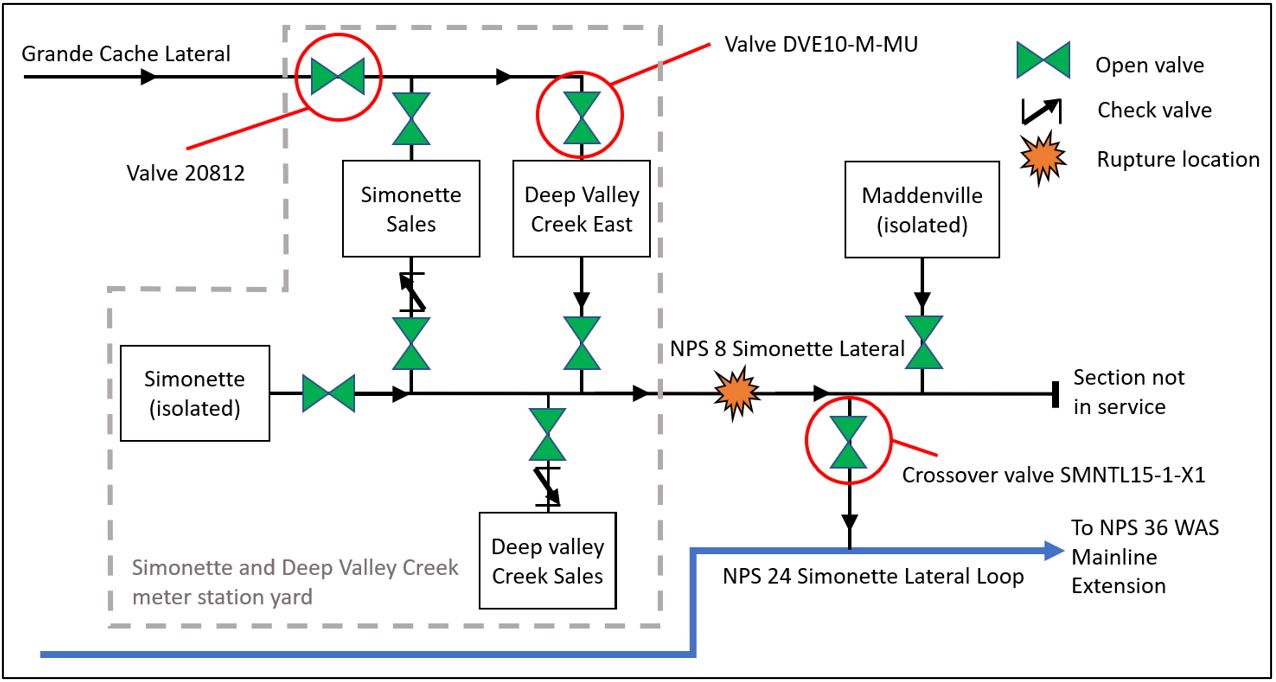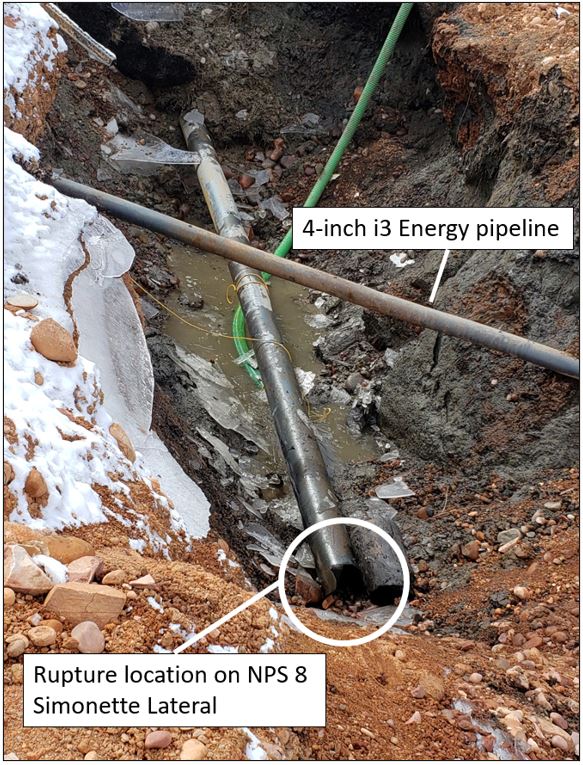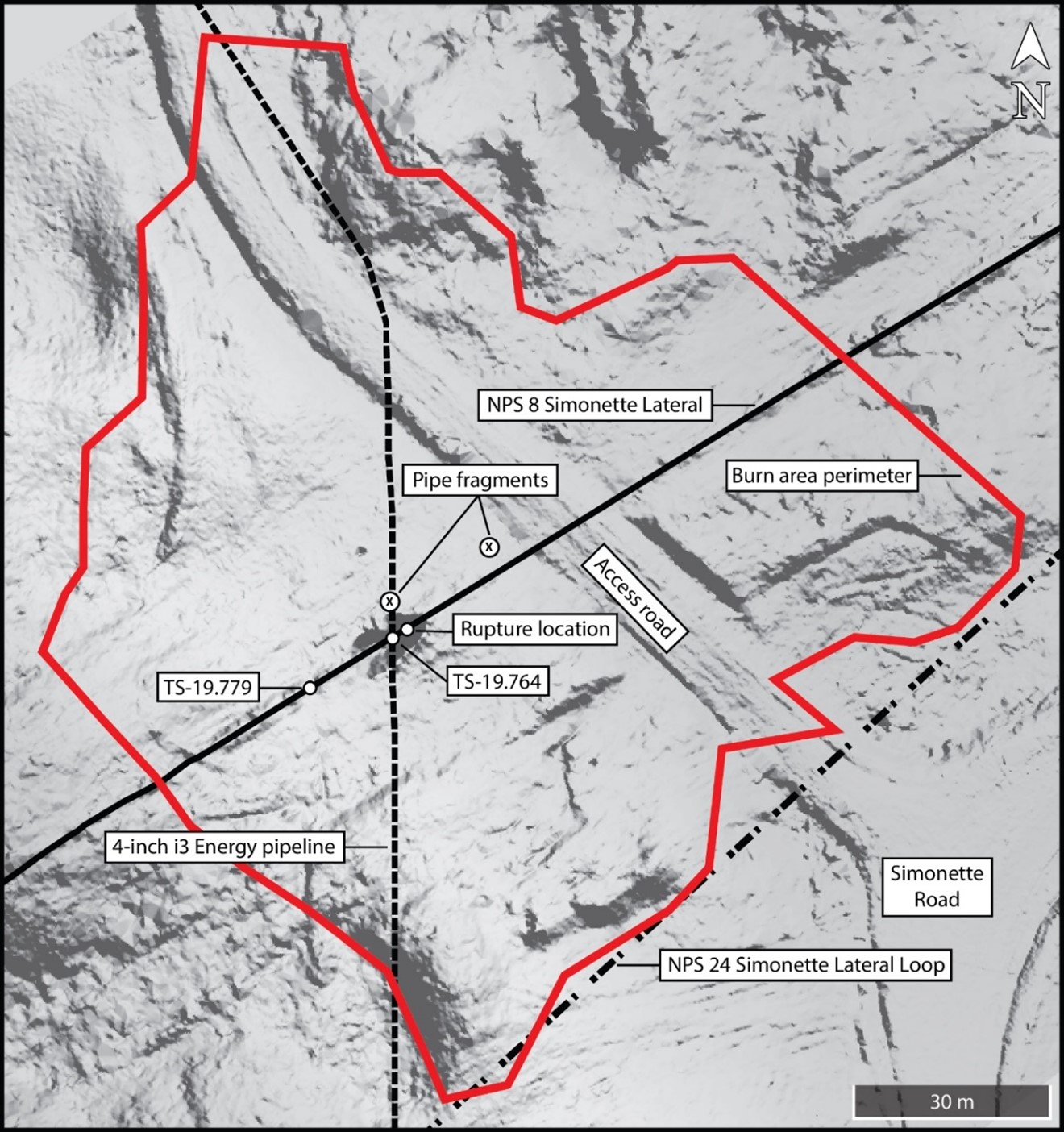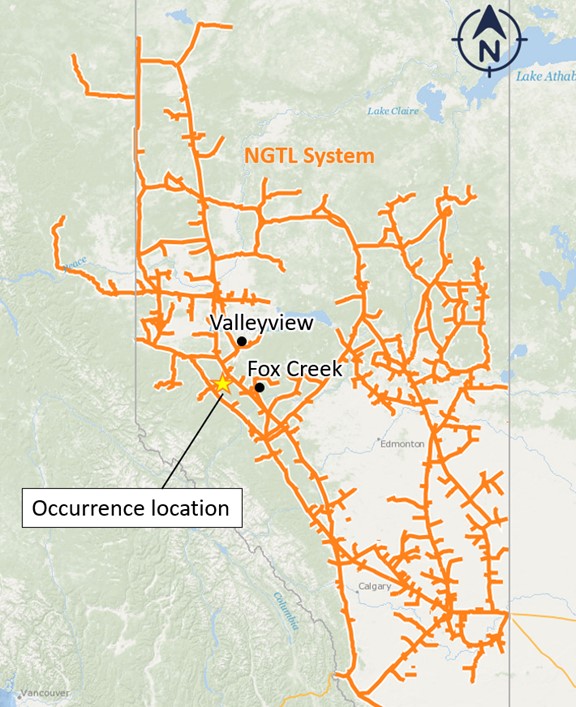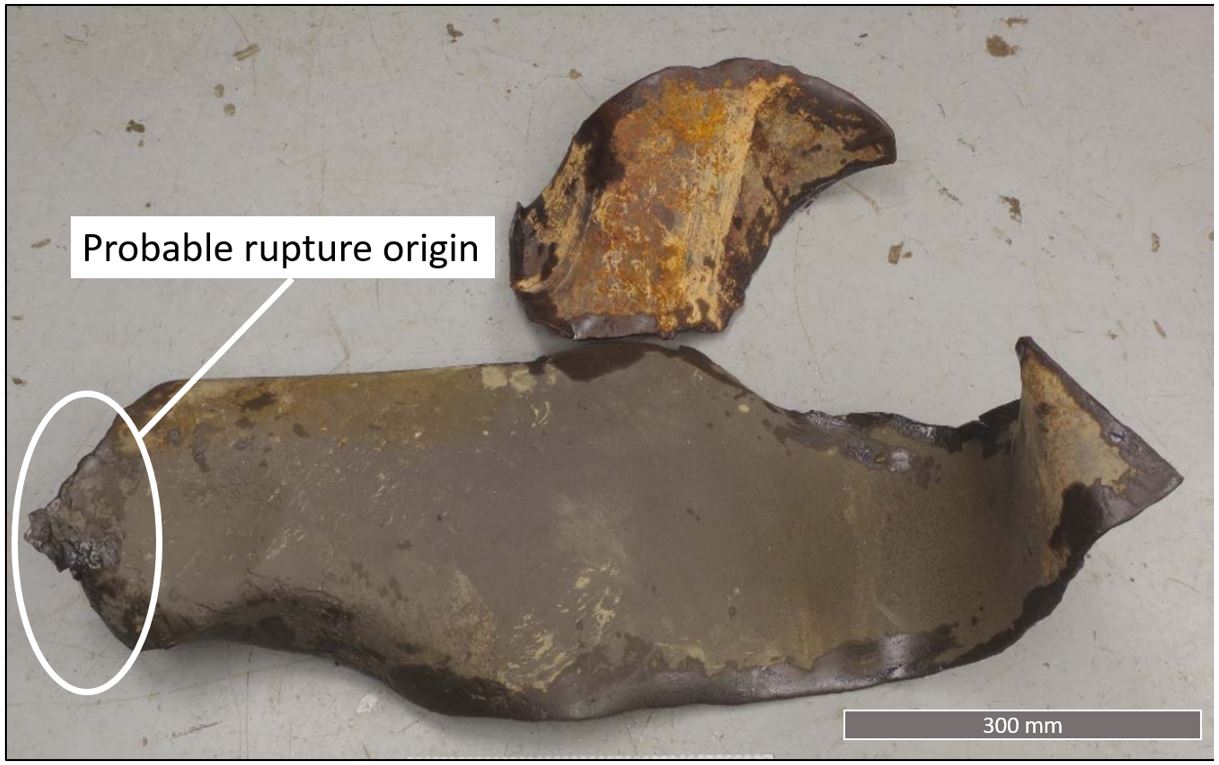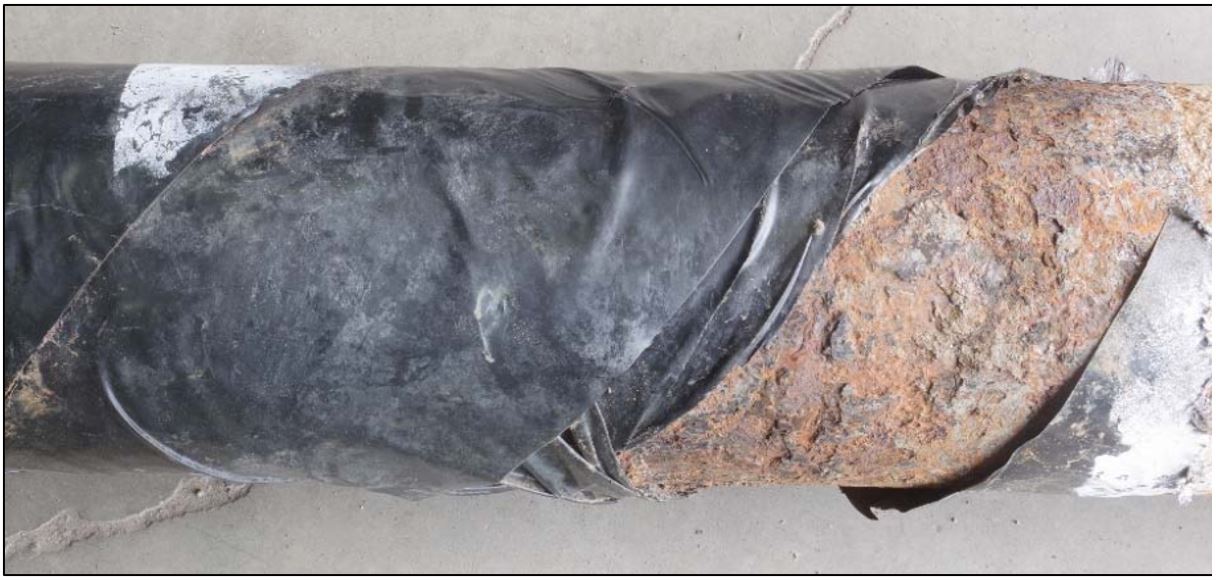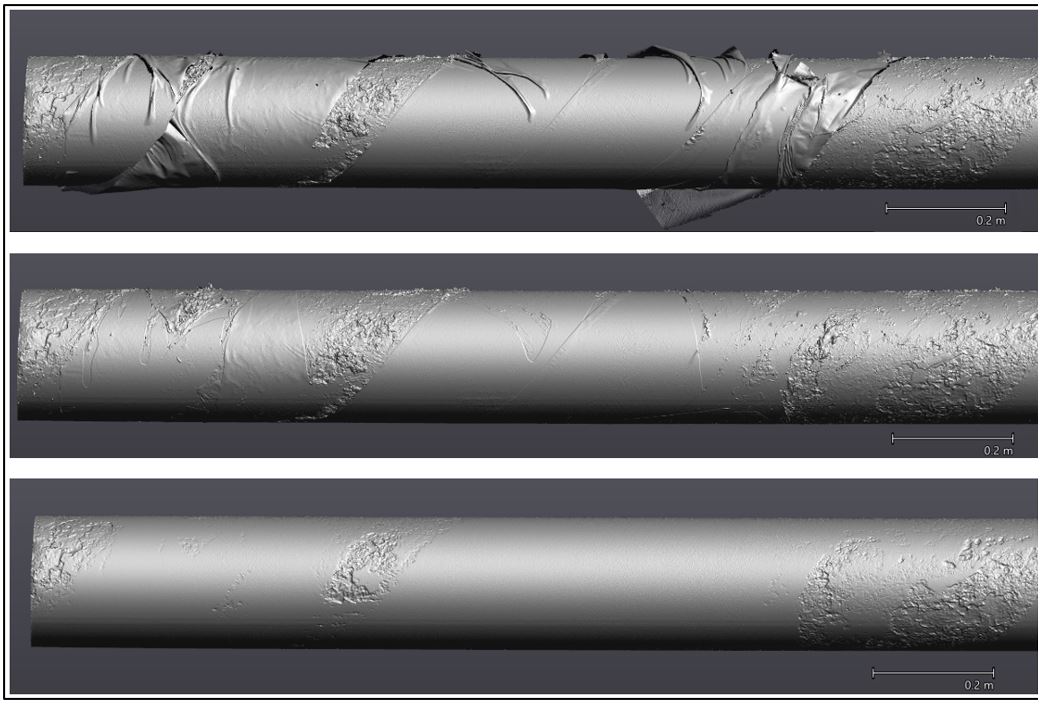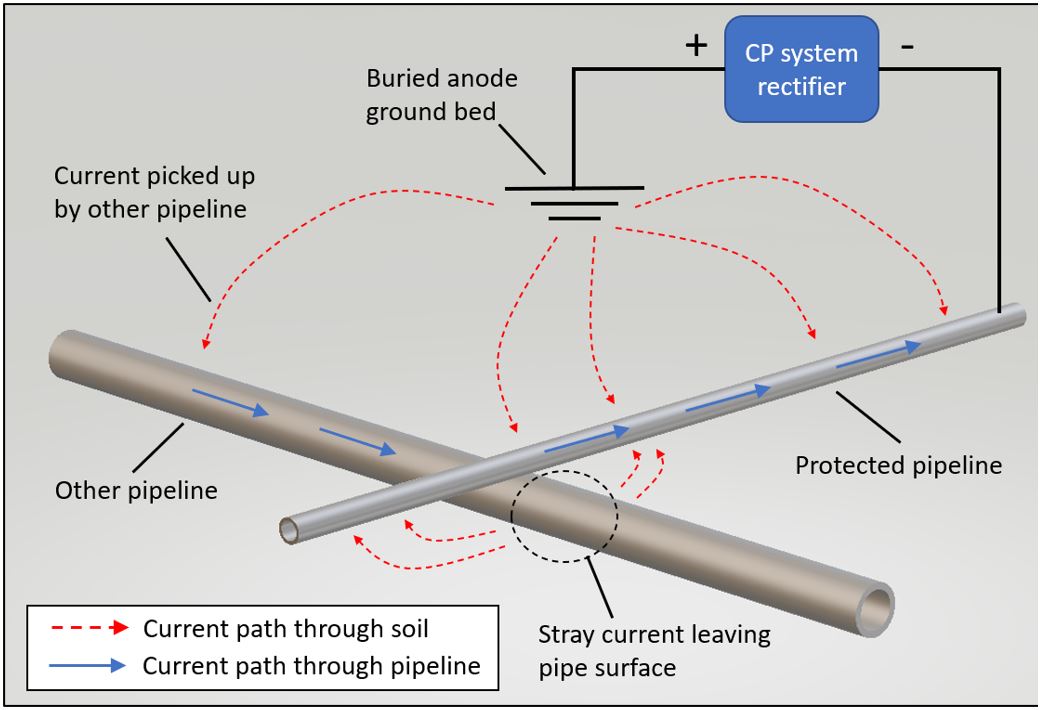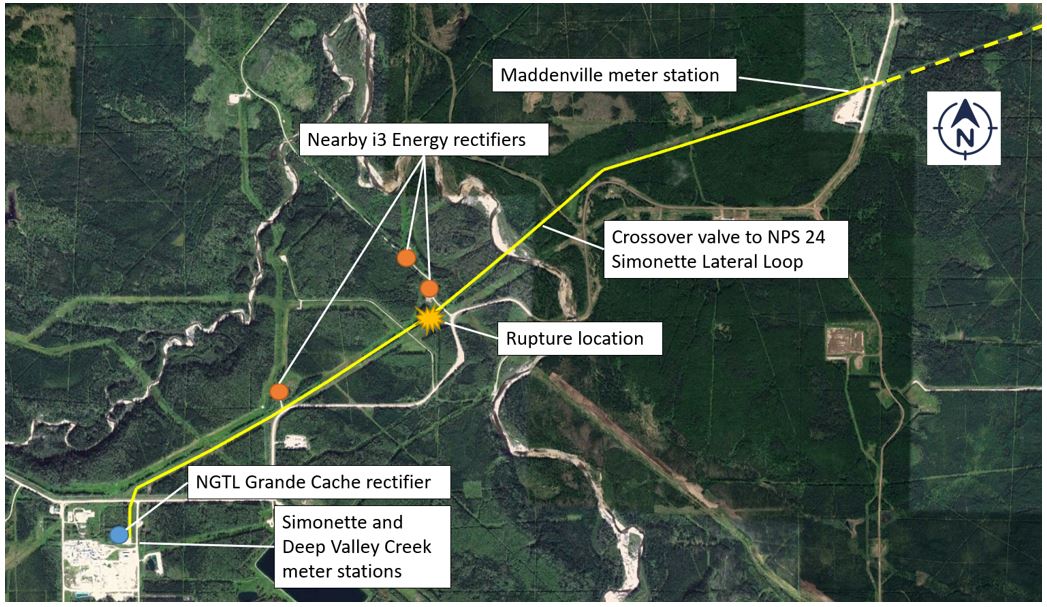Pipeline rupture and fire
NOVA Gas Transmission Ltd.
8-inch Simonette Lateral natural gas pipeline
Near Fox Creek, Alberta
The Transportation Safety Board of Canada (TSB) investigated this occurrence for the purpose of advancing transportation safety. It is not the function of the Board to assign fault or determine civil or criminal liability. This report is not created for use in the context of legal, disciplinary or other proceedings. See Ownership and use of content. Masculine pronouns and position titles may be used to signify all genders to comply with the Canadian Transportation Accident Investigation and Safety Board Act (S.C. 1989, c. 3).
Summary
On 07 April 2022, at approximately 0323 Mountain Daylight Time, an 8-inch (219.1 mm) pipeline operated by NOVA Gas Transmission Ltd. transporting sweet natural gas ruptured about 64 km west of Fox Creek, Alberta. Following the rupture, the natural gas ignited, resulting in a fire. Approximately 3 750 000 m3 of natural gas was released. The fire, which lasted about 4 hours, burned a 12 000 m2 area. There were no injuries, and no evacuation was required.
1.0 Factual information
1.1 The occurrence
On 07 April 2022, at approximately 0323,Footnote 1 an 8-inch (219.1 mm) natural gas pipeline operated by NOVA Gas Transmission Ltd.Footnote 2 (NGTL)—the NPS [nominal pipe size] 8 Simonette Lateral pipeline (NPS 8 Simonette Lateral)—ruptured at Kilometre Post 19.764. The escaping gas ignited and burned until about 0730; the fire self-extinguished after the flow of gas was stopped by manually closing isolating valves upstream and downstream of the rupture.
Approximately 3 750 000 m3 of natural gas was released. The fire burned a 12 000 m2 area. The nearest body of water, a creek located approximately 300 m downstream, was not affected. There were no injuries, and no evacuation was required.
At the time of the rupture, the NPS 8 Simonette Lateral was operating at 5074 kPa, within its licensed maximum operating pressure of 7540 kPa; there were no pressure restrictions in effect. The ambient temperature was around 7 °C, with wind speeds ranging from 0 to 20 km/h.
1.1.1 Occurrence location
The occurrence took place on Crown land in the Municipal District of Greenview, Alberta, on a right-of-way used by NGTL. The 2 nearest towns, Fox Creek and Valleyview, Alberta, are located approximately 64 km east and 75 km northeast, respectively.Footnote 3
The occurrence location (Figure 1) is surrounded by Crown land for a radius greater than 5 km. There are no dwellings within a 2 km radius.
1.1.2 Occurrence notification and response
On 07 April 2022 at 0325, the on-duty gas controller at the NGTL Calgary control centre received, through the Supervisory Control and Data Acquisition (SCADA) system, a low-pressure alarm from the Deep Valley Creek East meter station.Footnote 4 The gas controller suspected a leak as the cause for the alarm, identified the affected section of the pipeline, and initiated the response procedure.
1.1.2.1 Pipeline isolation
At 0328, Calgary control centre staff called the on-call TC Energy technician,Footnote 5 who was 90 km away, to respond to the occurrence. The on-call technician travelled to the site with another TC Energy technician.
At 0353, after analysing data from the SCADA system, Calgary control centre staff contacted the on-call operations planner to request a pipeline isolation plan, which was received at 0528.Footnote 6 According to the plan, the isolation of the ruptured section required the manual closing of 2 valvesFootnote 7—valve 20812, located within the Deep Valley Creek East meter station yard, and crossover valve SMNTL15-1-X1 connecting the NPS 8 Simonette Lateral to the parallel NPS 24 Simonette Lateral Loop (Figure 2).
At 0621, TC Energy technicians arrived at the occurrence location within the 3-hour timeframe specified in TC Energy’s Canada Gas Operations Emergency Program Manual. At 0642, the technicians manually closed crossover valve SMNTL15-1-X1. The technicians then travelled 3 km upstream to the Deep Valley Creek East meter station and closed valve DVE10-M-MU as an alternative to valve 20812Footnote 8 at 0700, which stopped the flow of gas into the ruptured section of the pipeline. The fire self-extinguished approximately 30 minutes later, by 0730.
Table 1 shows the sequence of events immediately following the occurrence.
| Time | Description |
|---|---|
| 0323 (approximately) | The NPS 8 Simonette Lateral pipeline ruptures at Kilometre Post 19.764. |
| 0325 | The Calgary control centre receives a SCADA system alarm from the Deep Valley Creek East meter station. |
| 0328 | TC Energy decides to shut down the pipeline, initiates response procedures, and notifies the on-call TC Energy technician to respond to the occurrence. |
| 0348 | The Keyera Simonette gas plant reports a fireball to local TC Energy personnel. |
| 0353 | Calgary control centre staff contacts the on-call operations planner to request a pipeline isolation plan. |
| 0528 | The operations planner sends the pipeline isolation plan to the gas controller. |
| 0621 | TC Energy personnel arrive at the occurrence location, and report that the fire and release are still ongoing. |
| 0642 | TC Energy personnel close crossover valve SMNTL15-1-X1, isolating the NPS 8 Simonette Lateral from the parallel NPS 24 Simonette Lateral Loop. |
| 0700 | TC Energy personnel close valve DVE10-M-MU at the Deep Valley Creek East meter station, stopping gas flow into the ruptured section. |
| 0730 | The fire at the occurrence location is completely extinguished. |
1.1.2.2 External notifications
At 0429, TC Energy reported the occurrence to the TSB. At 0615, TC Energy reported the occurrence to the provincial forest fire reporting line. At 0625, TC Energy reported the occurrence to the Royal Canadian Mounted Police (RCMP) and the Fox Creek Protective Services.
1.1.3 Damage and service interruptions
There was no damage to other nearby NGTL infrastructure.
The shutdown of the NPS 8 Simonette Lateral affected one natural gas customerFootnote 9 that was informed that it would lose supply from the Deep Valley Creek sales meter station.
As part of the pipeline isolation process, Calgary control centre staff instructed a gas producer in the area, Keyera Simonette, to interrupt the flow of gas into the pipeline network.
1.2 Site examination
The rupture created a 3.3 m deep crater with a 48 m perimeter and ejected approximately 23 m3 of soil. The soil in the area consisted of gravel and cobbles at the surface, with very little topsoil. Subsoil consisted of brown, fine sand and silt with some clay.
The NPS 8 Simonette Lateral was exposed at the bottom of the crater with its protective coating burned off. An out-of-service 4-inch pipeline, owned by i3 Energy Canada Ltd. (i3 Energy)Footnote 10 was also exposed within the crater; it was about 2 m above the ruptured pipeline, at an approximate 60° angle (Figure 3).
The 4-inch i3 Energy pipeline did not rupture, but its coating was missing, having been directly exposed to the fire. The damaged section of this pipeline was subsequently replaced. A nearby production facility and other pipelines owned by i3 Energy were not damaged.
Four wooden power poles owned and operated by ATCO Ltd.Footnote 11 as well as a connection to an underground power line were also damaged as a result of the rupture and fire; they were subsequently replaced.
Debris from the rupture was scattered primarily downhill in a northeast direction. Two ejected pipe fragments, along with 25 m of the ruptured section of the pipeline, were recovered for laboratory examination.
In the vicinity of the rupture, test stations TS-19.764 and TS-19.779—above-ground terminals connected to the buried pipe for measuring cathodic protection (CP) potential—were damaged. System components from these test stations were also recovered for laboratory analysis.
Figure 4 shows the main facilities within the perimeter of the burn area.
1.3 NPS 8 Simonette Lateral
1.3.1 Description of the pipeline
The NPS 8 Simonette Lateral is part of the NGTL system, a natural gas gathering and transportation system in Alberta and northeastern British Columbia (Figure 5). NGTL transports natural gas produced in the Western Canadian Sedimentary Basin to markets in Canada and the United States.
The NGTL system has approximately 24 500 km of operating pipelines with about 1100 receipt points and over 300 delivery points.
The NPS 8 Simonette Lateral is an 8-inch (219.1 mm) pipeline that links natural gas producers in the Simonette area near Fox Creek to NGTL’s NPS 36 Western Alberta System (WAS) Mainline Extension, 22.34 km to the northeast. In 2016, following the construction of a new 24-inch pipeline (NPS 24 Simonette Lateral Loop), a 16.94 km section of the NPS 8 Simonette Lateral was put out of service for operational reasons. The remaining 5.4 km in-service section of the NPS 8 Simonette Lateral connects to the NPS 24 Simonette Lateral Loop to transport natural gas to the WAS Mainline Extension (Figure 6).
The NPS 8 Simonette Lateral and the NPS 24 Simonette Lateral Loop can operate bidirectionally,Footnote 12 but the dominant gas flow direction is from the southwest toward the northeast.Footnote 13 They are both controlled from NGTL’s Calgary control centre. The Calgary control centre is compliant with the applicable provisions of American Petroleum Institute (API) Recommended Practice (RP) 1165 and follows industry best practices.
1.3.2 Pipeline construction
Construction of the NPS 8 Simonette Lateral took place in 1969. It was designed and constructed in accordance with the provisions of the American Society of Mechanical Engineers (ASME) standard B31.1.8-1955, Gas Transmission and Distribution Piping Systems and Canadian Standards Association (CSA) standard Z184-1968, and has the following specifications:
- Maximum operating pressure: 7540 kPa
- Class location: Class 1
- Type: Longitudinal-seam pipe
- Wall thickness: 3.96 mm
- Steel grade: API 5L X42
- Specified minimum yield strength: 290 MPa
- Minimum depth of cover: 762 mm
The longitudinal pipe seam was welded using electric resistance. The external coating was field-applied polyethylene tape coating with a fibreglass outer wrap impregnated with asphalt.
Before being put in service, the NPS 8 Simonette Lateral was subjected to a 24-hour hydrostatic test to a pressure of 9418 kPa.
1.4 Laboratory analysis
Approximately 25 m of pipe material recovered from the occurrence area was transported to the Acuren Group Inc. (Acuren) laboratory in Edmonton, Alberta, for analysis. The pipe material included parts of pipe joints 1700, 1710, and 1720 (Figure 7). The recovered CP system components from the TS-19.779 and TS-19.764 test stations were transported to the TSB Engineering Laboratory in Ottawa, Ontario, for analysis.
1.4.1 Pipe components
Examination of the ejected pieces of the pipe (Figure 8) found significant corrosion along one edge, identifying the probable location of the rupture origin. The probable rupture origin was located at the bottom of the pipe, approximately 3.5 m downstream of girth weld 1710. The edges of the ejected pieces showed features consistent with ductile fracture. No indication of prior cracking, brittle fracture, or any flaw such as stress corrosion cracking was observed. The minimum thickness measured at the probable rupture origin was 0.49 mm, an 88% reduction of the original wall thickness.
Mechanical testing found the tensile properties and composition of the pipe to meet both the specifications in effect at the time of constructionFootnote 14 and those in effect at the time of the occurrence.Footnote 15 Based on the remaining pipe thickness along the rupture edge, the theoretical rupture pressure was estimated to be 4683 kPa.
1.4.2 Pipe coating
The recovered pipe sections were examined to determine the coating condition and the extent of external corrosion. The external coating was originally installed in the field by applying an adhesive to the pipe and then wrapping polyethylene tape in a spiral configuration.
The areas of pipe exposed to the fire did not have any pipe coating remaining. The general condition of the remaining polyethylene tape coating was found to be very poor (Figure 9).
As part of the laboratory examination of the external pipe surface condition, 3 stages of 3-dimensional laser scans were performed. The initial scan was performed with the tape coating still in place, followed by a scan with the disbonded tape removed. A final scan was conducted after the pipe was sandblasted to remove all remaining tape coating and reveal the corroded pipe surface.
An example of the images produced by this technique is shown in Figure 10.
The images produced were analyzed to estimate the relative amount of disbonded coating and corroded surface area. The compiled results of the coating evaluation are presented in Table 2.
| Pipe section | Tape holidays* (%) | Tape disbondment** (%) | Bonded tape*** (%) | Corroded surface (%) |
|---|---|---|---|---|
| 1700-1 | 35 | 65 | 0 | 35 |
| 1700-2 | 30 | 50 | 20 | 30 |
| 1720 | 25 | 75 | 0 | 25 |
* Tape holidays refer to the areas where tape was missing.
** Disbondment refers to the areas where tape was present, but the adhesive had degraded.
*** Bonded tape refers to the areas where the tape coating was in good condition.
1.4.3 Microbiology
Analysis of soil samples and corrosion products at the pipe surface found bacteria such as pseudomonas and acinetobacter, both of which are known to degrade hydrocarbons. Over time, these bacteria can degrade the adhesive used to fix the field-applied tape coating to the pipe. The potential integrity threats due to bacterial activity are generally accounted for as part of a pipeline operator’s integrity management program (IMP).
1.4.4 Cathodic protection system components
The recovered components from the TS-19.779 and TS-19.764 CP test stations were examined by the TSB. The examination did not find any indication of pre-existing deficiencies with the test stations.
1.5 Regulatory requirements for integrity management
The Canada Energy Regulator (CER) Onshore Pipeline Regulations require a company to establish, implement, and maintain a management system and various protection programs, including an IMP. The Regulations further require pipeline operators, through incorporation by reference, to adhere to applicable mandatory provisions of the latest edition of CSA standard Z662, Oil and gas pipeline systems (CSA Z662), which provides the minimum requirements related to a pipeline’s design, construction, operation, maintenance, deactivation, and abandonment.
While the CER, in its Guidance Notes for the Canadian Energy Regulator Onshore Pipeline Regulations, provides direction in developing an IMP, regulated companies have flexibility and discretion to develop the content of their plans. In general, regulated companies develop IMPs tailored to their specific operations and take corrective actions as required, in compliance with applicable provisions and criteria set out in CSA Z662.
The CER expects companies, as part of their IMP, to proactively identify and continually monitor the specific hazards associated with their pipelines and associated facilities, and to update their program immediately when new hazards are identified.
CER-regulated companies are held accountable for operating safely during all phases of a pipeline life cycle. The CER monitors the effectiveness of each company’s program on an ongoing basis using audits and compliance verification activities to ensure that pipelines and associated facilities are suitable for continued safe, reliable, and environmentally responsible service.
1.6 Pipeline integrity management program
TC Energy’s IMP is the governing document the company uses for managing the integrity of the pipeline facilities it operates, including the NGTL system. TC Energy’s IMP uses a risk-based pipeline integrity management process. It is based on standards such as CSA Z662 as well as various other industry standards and recommended practices.
The IMP includes continuous monitoring of all the operation and maintenance aspects of line pipe and other facilities. As per TC Energy’s IMP, the NPS 8 Simonette Lateral is evaluated on an annual basis.Footnote 16
External corrosion, including bacterial activity affecting pipe coatings, is one of the system integrity threats identified in the IMP. TC Energy’s approach to quantifying and mitigating such threats for the NPS 8 Simonette Lateral includes the use of in-line inspections (ILI), integrity excavations, and management of CP systems.
1.6.1 In-line inspection
On 14 February 2016, an ILI Footnote 17 was performed to identify corrosion on the 5.4 km in-service section of the NPS 8 Simonette Lateral. It identified 2 areas of metal loss. Footnote 18 There were no areas of concern identified in the vicinity of the occurrence location. Based on a detailed assessment of the ILI tool performance, TC Energy was confident in the ILI tool’s ability to consistently identify features of interest within the established ILI cycle. The next ILI for the NPS 8 Simonette Lateral was scheduled to occur within a 7-year interval, before February 2023.
1.6.2 Integrity excavations
TC Energy uses integrity excavations as part of its IMP and to address ILI indications of interest. These integrity excavations also provide information that is used as part of TC Energy’s estimation of corrosion growth rates.
Two locations with areas of metal loss indications were excavated following the 2016 ILI. External corrosion defects of up to 65% wall thickness were found and subsequently repaired. A comparison of the as-found features from the integrity excavations showed good correlation with the ILI data.
The corrosion growth rates for the NPS 8 Simonette Lateral are determined by TC Energy based on a segment-based approach, taking into consideration parameters such as coating, operating conditions, as well as defect severity and density. For the segment of pipe at the occurrence location, the maximum growth rate was determined to be 0.04 mm/year.
As part of TC Energy’s IMP, another integrity excavation was performed 2.3 km upstream of the occurrence location in February 2022. The integrity excavation confirmed the validity of the corrosion growth rate used at the time of the 2016 integrity assessment and validated maintaining the selected re-inspection interval of 7 years.
1.7 Cathodic protection
All buried pipelines are susceptible to external corrosion, which can render the pipe unable to withstand the operating pressure of the line.
Protecting a buried pipeline system from external corrosion is achieved with an external coating and a CP system. The primary purpose of the external coating is to act as a barrier between the pipe surface and the external environment. If the external coating degrades or otherwise fails, the CP system is designed to protect the pipe from corrosion by maintaining a negative charge on the pipe such that an anodic reaction cannot occur.
CSA Z662 requires that all CP systems be monitored periodically to verify their satisfactory operation. CSA Z662 references Canadian Gas Association Recommended Practice OCC-1 for guidance on the frequency of surveys, which specifies a minimum of once per calendar year.
To ensure that CP systems remain effective at preventing corrosion, regular monitoring is carried out by measuring the pipe-to-soil potential using a reference electrode and a CP test station that is electrically connected to the pipe. Measured potential values are then analyzed and compared to CP criteria.
1.7.1 Impressed current cathodic protection
In an impressed current cathodic protection (ICCP) system, electrical current is supplied by a rectifierFootnote 19 and a buried anode ground bed. Direct currentFootnote 20 travels from the anode ground bed to the pipe through the soil and is returned to the rectifier through the pipe to complete the circuit. Exposed areas of pipe metal that receive current are protected. The amount of current required to maintain a protective voltage on the pipe surface depends on the amount of exposed pipe, distance to the anode ground bed, and the resistivity of the soil electrolyte.
1.7.2 Stray current interference
In areas where multiple pipelines are located in close proximity, interactions between ICCP systems can occur. The current supplied by one system’s rectifier can be picked up by other nearby pipelines. The current then travels through the soil from one pipeline to the other on its return path to the rectifier. This type of interaction between systems is known as stray current interference (Figure 11). Where the stray current leaves the other nearby pipeline through the soil, an anodic reaction can occur, which induces corrosion on the other pipeline. The corrosion rate is proportional to the amount of current leaving the pipe surface.
Interference can be mitigated by providing a lower-resistance metal pathway for the stray current. This is generally accomplished through electrically bonding the pipelines together.
1.7.3 NPS 8 Simonette Lateral cathodic protection system
The NPS 8 Simonette Lateral has an ICCP system installed as part of its management of external corrosion. TC Energy’s standard TEN-CP-SURVY-GL, Corrosion Prevention Survey Standard, applies to the NGTL system (including the NPS 8 Simonette Lateral) and includes standards for the installation and operation of CP systems. In Alberta, TC Energy’s criterion for the operation and maintenance of CP is to achieve an “on” potentialFootnote 21 more negative than −950 mV.
1.7.3.1 Rectifiers and anode beds in the vicinity of the occurrence
There are 3 NGTL rectifiers and anode ground beds in the vicinity of the occurrence location that contribute CP current to the NPS 8 Simonette Lateral (Table 3).
| Rectifier name | Distance to occurrence location | Status |
|---|---|---|
| Grande Cache | 2.6 km | Operational |
| Deep Valley | 16.5 km | Operational |
| Waskahigan | 19.9 km | De-energized |
Since 2016, the following CP rectifier outages were experienced:
- The Deep Valley rectifier was de-energized between 04 December 2018 and 25 February 2021.
- The Waskahigan rectifier was de-energized on 07 February 2022.
On 13 May 2021, TC Energy conducted influence testingFootnote 22 at the TS-19.764 test station near the occurrence location to measure the contribution of each rectifier to the CP of the NPS 8 Simonette Lateral. According to the results, each of the 3 rectifiers had a low level of influence on the CP of the pipeline at the occurrence location.
A network of ICCP rectifiers and anode ground beds owned and operated by i3 Energy is also located in the vicinity of the occurrence (Table 4). These facilities provide CP to i3 Energy’s assets in the Simonette area.
| Cathodic protection system | Distance to occurrence location | Status |
|---|---|---|
| 05-09-063-25 W5M (R-4) | 0.1 km | Ground bed depleted |
| 12-09-063-25 W5M (R-8) | 0.3 km | Operational |
| 02-08-063-25 W5M (R-11) | 1.1 km | Operational |
The i3 Energy CP system closest to the occurrence location is 05-09-063-25 W5M (R-4). This CP system’s output had been decreasing since at least 2013 and the anode ground bed was depleted at the time of i3 Energy’s 2020 annual CP survey, indicating that the CP system had reached the end of its useful life. i3 Energy was aware of the depleted anode ground bed and determined that no further action was necessary as other i3 Energy CP systems were operational in the area. In December 2021, i3 Energy conducted its annual CP survey, which confirmed that all of its structures in the Simonette area had adequate levels of CP.
Figure 12 shows the locations of the NGTL and i3 Energy rectifiers within 2 km of the occurrence location.
1.7.3.2 Critical bonds
Electrical bonds connect pipelines together and are often used as a mitigation against stray current interference. TC Energy considers such bonds as critical if they meet any of the following conditions:
- Bond materials and installation are considered prone to failure (e.g., variable resistors used, susceptibility to physical damage by livestock, traffic, farming equipment, etc.).
- The bond is providing CP current to company structures and has more influence than the nearest rectifier on the CP of company structures in the area of the bond location.
- Removal of the bond moves the polarized potential of company structures by 100 mV or more, in the anodic direction, in the area of the bond location (note: polarization levels must be stabilized).
- There is a significant risk of foreign abnormal operations (e.g., reversed polarity at a foreign rectifier with no diode installed).
There was an electrical bond at the TS-19.764 test station connecting the NPS 8 Simonette Lateral to a nearby 4-inch pipeline owned by i3 Energy.Footnote 23 TC Energy’s application of its Corrosion Prevention Survey Standard to the 2021 survey and diagnostic testing of TS-19.764 identified this bond as critical.
In 2019, TC Energy’s Corrosion Prevention Survey Standard was updated to require monthly monitoring for all critical electrical bonds connecting one or more pipelines together. Following this update, the critical bonds of CP systems on the NGTL system were exempted from the monthly monitoring requirement until 31 December 2019 due to limitations in technician resources. However, as technician resource constraints remained in 2020 and 2021, no monthly monitoring program was initiated following the exemption expiration.
1.7.4 Diagnostic testing at TS-19.764
In addition to scheduled monitoring of CP systems, TC Energy conducts diagnostic testing when CP deficiencies are discovered to determine the root cause and to develop remediation plans.
During the 2020 annual CP survey, TC Energy discovered low levels of CP at the TS-19.764 test station near the occurrence location. This discovery prompted TC Energy to include the pipeline section located in the vicinity of occurrence into a 3-year CP project cycle, which runs as follows:
- Year 1: Identification
- Year 2: Investigation
- Year 3: Remediation
There is no procedure to expedite the CP project cycle if anomalies are encountered during testing before the planned remediation phase in year 3.
The following activities were completed between August 2020 and February 2022 as part of the identification and investigation phases:
- Close interval survey – Higher resolution measurement of pipe-to-soil potentials discovered an area near the TS-19.764 test station where CP did not meet the criteria.
- Bond testing – Testing revealed that the electrical bond was necessary to mitigate interactions with the nearby third-party pipeline.
- Soil resistivity testing – The soil resistivity was measured on 05 August 2021 near the occurrence location to be 1417.1 ohm-cm, which is low or “highly corrosive” according to industry references.Footnote 24
- Current requirement testing – This testing was conducted to determine if adding more current would address the low levels of CP at the occurrence location. Output of the existing Grande Cache rectifier was increased as an interim measure, but was unable to provide enough current to bring CP to an adequate level at the occurrence location.
- Influence testing – Testing showed that the 3 NGTL rectifiers had minimal CP influence at the occurrence location.
- Electro-potential readings – i3 Energy’s readings at the 05-09-063-25 W5M (R-4) rectifier indicated that the ground bed at this location was depleted.
On 12 May 2021, TC Energy contacted i3 Energy to request information about CP systems in the area near TS-19.764. i3 Energy was unaware of the existence of a bond at this location before being contacted by TC Energy. On 29 July 2021, TC Energy informed i3 Energy that third-party CP influence testing would take place the following week, which required the participation of i3 Energy.Footnote 25 However, the third-party CP influence testing activity was not carried out because the testing schedule was not coordinated between the companies.
On 13 August 2021, TC Energy visited the TS-19.764 test station as part of its annual CP survey; further decay of CP potential measurements at the TS-19.764 test station since the 2020 annual survey was noted. The critical bond at TS-19.764 was noted to be connected at the time that the TC Energy technicians completed the survey.
In December 2021, i3 Energy’s CP contractor visited the TS-19.764 test station as part of i3 Energy’s annual CP survey and noted that the bond was “disconnected.”
On 01 February 2022, TC Energy undertook the installation of a remote monitoring unit at the TS-19.764 test station for real-time remote monitoring. During the installation of the remote monitoring unit, a TC Energy technician noted that the existing bond at TS-19.764 was “loose and not making complete electrical contact.” The remote monitoring unit replaced the test station equipment and bond at this location, which restored the electrical bond connection.
A timeline of CP activities at the TS-19.764 test station is presented in Appendix A.
1.8 TSB laboratory reports
The TSB completed the following laboratory reports in support of this investigation:
- LP099/2022 – Examination of Cathodic Protection Test Posts and Other Wreckage
- LP078/2023 – Failure Analysis of Natural Gas Pipeline Rupture and Fire (Review of Acuren Laboratory Report)
2.0 Analysis
The analysis will focus on cathodic protection (CP), integrity management, and emergency response.
2.1 The occurrence
The NOVA Gas Transmission Ltd. (NGTL) NPS (nominal pipe size) 8 Simonette Lateral pipeline (NPS 8 Simonette Lateral) ruptured near the TS-19.764 test station at a crossing with an out-of-service 4-inch pipeline owned by i3 Energy Canada Ltd. (i3 Energy). The escaping gas ignited and burned for approximately 4 hours.
Laboratory analysis of the pipe material determined that, at the rupture location, the pipe wall had lost up to 88% of its original wall thickness due to external corrosion, reducing the pipe strength. It also determined that the operating pressure of the pipeline at the time of the occurrence was 5074 kPa, which exceeded the estimated pressure retaining capacity of 4683 kPa at the rupture location. There were no geological, external interference, or overpressure events leading up to the rupture.
Finding as to causes and contributing factors
The NGTL NPS 8 Simonette Lateral pipeline, operating under normal conditions, ruptured due to reduced pipe wall strength caused by external corrosion, leading to an explosion and fire.
2.2 Prevention of external corrosion
The control of external corrosion of a buried pipeline system is normally accomplished using a dual system of external coatings and CP. The primary purpose of the external coating is to protect the pipe surface from its external environment. In the event that the external coating degrades or otherwise fails, the CP system is designed to protect the pipe from corrosion.
2.2.1 External coating
Laboratory examination found that the external field-applied polyethylene tape coating on the NPS 8 Simonette Lateral in the vicinity of the occurrence location had degraded, leaving 25-35% of the pipe surface exposed to the external soil environment. While the tape coating at the occurrence location could not be directly assessed, having been burned in the fire, it is likely that it was in a similarly poor condition in the time leading up to the rupture.
Finding as to causes and contributing factors
The pipeline’s external coating system had degraded over time, exposing the surface of the pipe in the vicinity of the occurrence to the external soil environment.
2.2.2 Cathodic protection
The NPS 8 Simonette Lateral has an impressed current cathodic protection (ICCP) system to maintain an electrical potential on the pipeline, protecting exposed areas from external corrosion. TC Energy considers a pipe-to-soil potential more negative than −950 mV to be acceptable to ensure adequate protection of the pipe surface. Pipe-to-soil potential measurements taken as part of TC Energy’s 2020 annual survey indicated that the CP at the occurrence location did not meet this criterion. TC Energy increased the output of a nearby existing CP rectifier as an interim measure until a permanent solution could be implemented. However, the pipe-to-soil potentials did not reach the required level at the occurrence location up until the time of the occurrence.
2.2.3 Stray current interference
In the area of the occurrence, the NPS 8 Simonette Lateral crosses a 4-inch i3 Energy pipeline located 2 m above it. At the time of the occurrence, each of these pipelines was connected to its own separate ICCP system.
In areas where multiple pipelines are located in close proximity, such as in this occurrence, interactions between CP systems can occur. The current supplied by one system’s rectifier can be picked up by other nearby pipelines. The current then travels through the soil from one pipeline to the other on its return path to the rectifier. The soil in the area of the occurrence had low resistivity, providing an electrical pathway through the soil.
A stray current interference mitigation bond existed at the occurrence location at the TS-19.764 test station, electrically connecting the NPS 8 Simonette Lateral to the 4-inch i3 Energy pipeline. The bond at TS-19.764 was necessary to mitigate the effects of stray CP current between the 2 pipelines. In February 2022, as part of the installation of a remote monitoring unit, TC Energy noted that the bond at TS-19.764 was “loose and not making complete electrical contact.” However, no further action was taken because the installation of the remote monitoring unit remedied the disconnected bond.
Corrosion occurred where external tape coating was not present, indicating that the CP system was not adequately protecting the exposed surface of the pipe as intended. Stray current interference at the occurrence location led to an anodic reaction at the exposed pipe surfaces, resulting in an accelerated rate of corrosion of the NPS 8 Simonette Lateral.
Finding as to causes and contributing factors
The NPS 8 Simonette Lateral’s proximity to a nearby i3 Energy pipeline, combined with degraded pipe coating, low soil resistivity, and an incomplete electrical bond, contributed to stray current interference. This led to accelerated external corrosion of the NPS 8 Simonette Lateral at the occurrence location.
2.2.3.1 Critical electrical bonds
The electrical bond connecting the NPS 8 Simonette Lateral and the 4-inch i3 Energy pipeline was necessary to mitigate against stray current interference. The bond was a critical bond because it had a significant influence on CP performance in the area of the occurrence.
According to TC Energy’s Corrosion Prevention Survey Standard, critical bonds require monthly monitoring to ensure that they are functioning correctly. However, in 2019, critical bonds on the NGTL system were exempted from the monthly monitoring requirement due to a lack of technician resources. Although the exemption had an end date of 31 December 2019, it was carried forward into the subsequent years without further assessment.
The critical bond at TS-19.764 was visited by TC Energy as part of its annual CP survey for the NPS 8 Simonette Lateral in August 2021 but was not continuously monitored until a remote monitoring unit was installed in February 2022.
Finding as to causes and contributing factors
The critical bond at TS-19.764 was not monitored between August 2021 and February 2022. As a result, the stray current interference at the occurrence location remained unmitigated for up to 5 months.
2.3 Integrity management
The NPS 8 Simonette Lateral was internally inspected on 14 February 2016 and no corrosion was detected at the occurrence location. TC Energy’s re-inspection interval for the NPS 8 Simonette Lateral was established at 7 years, with the next scheduled inspection to take place before February 2023.
During diagnostic testing at the occurrence location, TC Energy had identified CP issues that could affect the integrity of the NPS 8 Simonette Lateral. However, TC Energy did not consider inadequate CP to require a re-evaluation of external corrosion risk on the NPS 8 Simonette Lateral. Significant corrosion at the occurrence location likely started after the 2016 in-line inspection and that corrosion proceeded at a rate above the predicted 0.04 mm/year at the occurrence location.
Finding as to causes and contributing factors
TC Energy’s 7-year in-line inspection interval for the NPS 8 Simonette Lateral did not take into account the threat of localized accelerated corrosion due to CP issues. As a result, the corrosion at the rupture location grew to the point of failure before the next scheduled pipeline inspection.
The NGTL system is an extensive network of gathering and transmission pipelines that cover a large area of western Canada. These pipelines often share rights-of-way, cross, and interconnect with other operators. Interactions between CP systems can affect their effectiveness where pipelines are in close proximity.
i3 Energy operates CP systems in the Simonette area to protect a network of pipelines and wells. There are i3 Energy rectifiers and ground beds in proximity to the NPS 8 Simonette Lateral, closer to the occurrence location than any of the contributing NGTL CP systems. Despite a nearby anode ground bed being depleted, i3 Energy’s 2021 annual CP survey indicated that its assets in the Simonette area were receiving adequate protection, including the 4-inch pipeline that crosses the NPS 8 Simonette Lateral at the occurrence location.
Determining CP influence requires sharing operating information and physically interrupting third-party rectifiers to quantify the extent of interference between systems. No third-party CP influence testing was performed by TC Energy as part of its diagnostic testing in the vicinity of the occurrence location. Furthermore, TC Energy was unable to obtain complete field-level knowledge of the operating characteristics or locations of i3 Energy’s CP systems in close proximity to the NPS 8 Simonette Lateral. As a result, the effect of i3 Energy’s CP system on the NPS 8 Simonette Lateral at the occurrence location was not fully understood and the extent of stray current interference was not quantified.
Finding as to risk
If a pipeline operator is not fully aware of the operating characteristics of third-party CP infrastructure in close proximity to its pipelines, CP effectiveness may be compromised, increasing the risk of corrosion.
As demonstrated in this occurrence, pipelines located in close proximity to one another can affect CP effectiveness. The coordination between parties for the exchange of information about the operation of CP systems protecting these pipelines was informal and incomplete. While pipelines are required to have CP systems, there is no requirement to provide the operating characteristics or locations of these systems, nor is there an organized industry forum for sharing this information.
Other finding
There is no centralized system in Canada for consolidating information about pipeline CP system locations and operating characteristics.
2.4 Emergency response
Following the occurrence, the initial alarms received by TC Energy’s gas control centre provided enough information to recognize an issue in the Simonette area of the NGTL system at 0325 on 07 April 2022. TC Energy activated response procedures within 3 minutes of the issue being recognized. Information received by TC Energy after the initial issue identification, including a report of a fireball sighted from a gas plant in the area, indicated that there was a loss of primary containment on the NPS 8 Simonette Lateral. Technicians arrived on site at 0621, which was within the TC Energy response policy’s 3-hour target. While the technicians were travelling to the occurrence location, TC Energy’s on-call staff developed an isolation plan to stop gas flow into the ruptured section of pipe. None of the valves indicated on the isolation plan were remote-control valves and, therefore, they were unable to be remotely actuated by the Calgary gas control centre.
The crossover valve from the NPS 8 Simonette Lateral to the parallel NPS 24 Simonette Lateral Loop was manually closed at 0642. Staff travelled to the Deep Valley Creek East meter station and isolated the NPS 8 Simonette Lateral at 0700.
Finding as to risk
If a ruptured transmission pipeline is not isolated in a timely manner, the resulting consequences may be more severe, increasing the risk to people, property and the environment.
3.0 Findings
3.1 Findings as to causes and contributing factors
These are conditions, acts or safety deficiencies that were found to have caused or contributed to this occurrence.
- The NOVA Gas Transmission Ltd. NPS (nominal pipe size) 8 Simonette Lateral pipeline, operating under normal conditions, ruptured due to reduced pipe wall strength caused by external corrosion, leading to an explosion and fire.
- The pipeline’s external coating system had degraded over time, exposing the surface of the pipe in the vicinity of the occurrence to the external soil environment.
- The NPS (nominal pipe size) 8 Simonette Lateral’s proximity to a nearby i3 Energy Canada Ltd. pipeline, combined with degraded pipe coating, low soil resistivity, and an incomplete electrical bond, contributed to stray current interference. This led to accelerated external corrosion of the NPS 8 Simonette Lateral at the occurrence location.
- The critical bond at TS-19.764 was not monitored between August 2021 and February 2022. As a result, the stray current interference at the occurrence location remained unmitigated for up to 5 months.
- TC Energy’s 7-year in-line inspection interval for the NPS (nominal pipe size) 8 Simonette Lateral did not take into account the threat of localized accelerated corrosion due to cathodic protection issues. As a result, the corrosion at the rupture location grew to the point of failure before the next scheduled pipeline inspection.
3.2 Findings as to risk
These are conditions, unsafe acts or safety deficiencies that were found not to be a factor in this occurrence but could have adverse consequences in future occurrences.
- If a pipeline operator is not fully aware of the operating characteristics of third-party cathodic protection infrastructure in close proximity to its pipelines, cathodic protection effectiveness may be compromised, increasing the risk of corrosion.
- If a ruptured transmission pipeline is not isolated in a timely manner, the resulting consequences may be more severe, increasing the risk to people, property and the environment.
3.3 Other findings
These items could enhance safety, resolve an issue of controversy, or provide a data point for future safety studies.
- There is no centralized system in Canada for consolidating information about pipeline cathodic protection system locations and operating characteristics.
4.0 Safety action
4.1 Safety action taken
4.1.1 Canada Energy Regulator
The Board is not aware of any safety action taken following the occurrence.
4.1.2 TC Energy
After the occurrence, TC Energy replaced the damaged sections of pipe of the NPS 8 Simonette Lateral and initiated steps to permanently shut down and abandon the entire pipeline.
This report concludes the Transportation Safety Board of Canada’s investigation into this occurrence. The Board authorized the release of this report on . It was officially released on .
Appendices
Appendix A – Timeline of cathodic protection activities at TS-19.764
| Date | Activity |
|---|---|
| 05 Jun 2016 | TC Energy’s 2016 annual cathodic protection (CP) survey shows adequate protection. |
| 01 Sep 2016 | NOVA Gas Transmission Ltd. (NGTL) acquires the Grande Cache ground bed and rectifier and connects it to its CP system. |
| 02 Aug 2017 | TC Energy’s 2017 annual CP survey shows adequate protection. |
| 18 Jul 2018 | TC Energy’s 2018 annual CP survey shows adequate protection. |
| 06 Mar 2019 | The NGTL system is exempted from the monthly monitoring requirement due to limitations in technician resources. |
| 31 Jul 2019 | TC Energy’s 2019 annual CP survey shows adequate protection. |
| 04 Aug 2020 | TC Energy’s 2020 annual CP survey shows CP measured at −849 mV, which does not meet the criteria. |
| 15 Apr 2021 | The TS-19.764 test station location is included in CP testing/remediation project cycle. |
| 11 May 2021 | TC Energy conducts a close interval survey. The least negative reading of −787 mV is recorded near the TS-19.764 test station. The existing bond is replaced with a lower resistance (0.1 ohm) wire. |
| 06 Jul 2021 | Bond testing shows a 0.9 A bond current travelling to the 4-inch i3 Energy pipeline. |
| 04 Aug 2021 | TC Energy conducts a close interval survey. The least negative reading of −718 mV is near the TS-19.764 test station. Current requirement testing reveals more current is required to meet CP criteria. Direct bond deemed necessary to mitigate interference. Soil resistivity is measured at 1417.1 ohm-cm. |
| 05 Aug 2021 | TC Energy increases output at the Grande Cache rectifier. The bond current is measured at over 1 A travelling to the 4-inch i3 Energy pipeline through bond. |
| 13 Aug 2021 | TC Energy’s 2021 annual survey shows CP measured at −774 mV, which does not meet the criteria. The electrical bond at TS-19.764 was left connected at this time. |
| Dec 2021 | i3 Energy conducts an annual CP survey and notes adequate protection of all structures in the Simonette area. The contractor notes that the bond at TS-19.764 is disconnected. |
| 01 Feb 2022 | NGTL installs a remote monitoring unit. During installation, it is noted that the former bond was loose and not making complete electrical contact. |
| 07 Apr 2022 | The pipeline rupture occurs near the TS-19.764 test station. |
